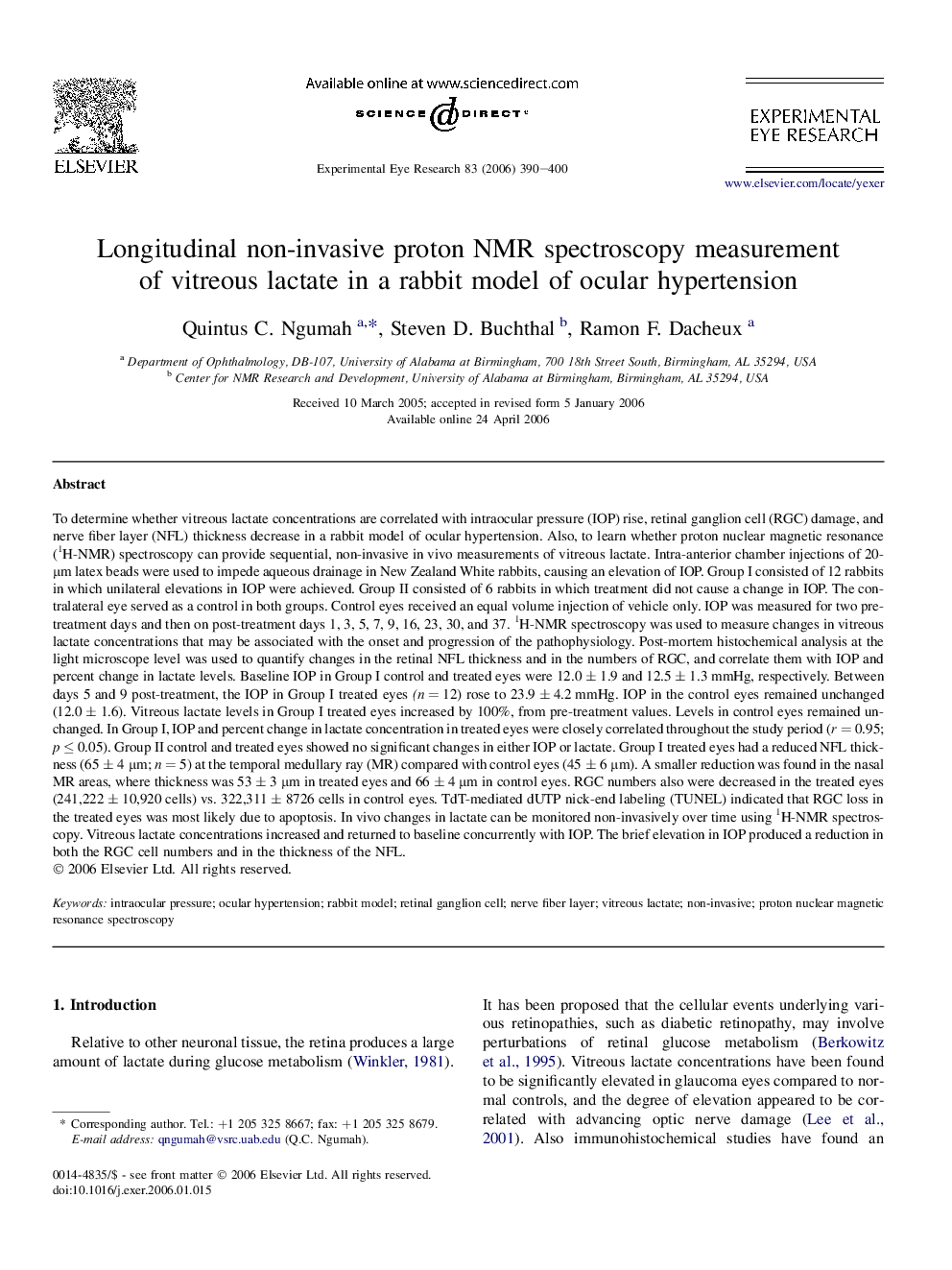| کد مقاله | کد نشریه | سال انتشار | مقاله انگلیسی | نسخه تمام متن |
|---|---|---|---|---|
| 4012585 | 1261201 | 2006 | 11 صفحه PDF | دانلود رایگان |

To determine whether vitreous lactate concentrations are correlated with intraocular pressure (IOP) rise, retinal ganglion cell (RGC) damage, and nerve fiber layer (NFL) thickness decrease in a rabbit model of ocular hypertension. Also, to learn whether proton nuclear magnetic resonance (1H-NMR) spectroscopy can provide sequential, non-invasive in vivo measurements of vitreous lactate. Intra-anterior chamber injections of 20-μm latex beads were used to impede aqueous drainage in New Zealand White rabbits, causing an elevation of IOP. Group I consisted of 12 rabbits in which unilateral elevations in IOP were achieved. Group II consisted of 6 rabbits in which treatment did not cause a change in IOP. The contralateral eye served as a control in both groups. Control eyes received an equal volume injection of vehicle only. IOP was measured for two pre-treatment days and then on post-treatment days 1, 3, 5, 7, 9, 16, 23, 30, and 37. 1H-NMR spectroscopy was used to measure changes in vitreous lactate concentrations that may be associated with the onset and progression of the pathophysiology. Post-mortem histochemical analysis at the light microscope level was used to quantify changes in the retinal NFL thickness and in the numbers of RGC, and correlate them with IOP and percent change in lactate levels. Baseline IOP in Group I control and treated eyes were 12.0 ± 1.9 and 12.5 ± 1.3 mmHg, respectively. Between days 5 and 9 post-treatment, the IOP in Group I treated eyes (n = 12) rose to 23.9 ± 4.2 mmHg. IOP in the control eyes remained unchanged (12.0 ± 1.6). Vitreous lactate levels in Group I treated eyes increased by 100%, from pre-treatment values. Levels in control eyes remained unchanged. In Group I, IOP and percent change in lactate concentration in treated eyes were closely correlated throughout the study period (r = 0.95; p ≤ 0.05). Group II control and treated eyes showed no significant changes in either IOP or lactate. Group I treated eyes had a reduced NFL thickness (65 ± 4 μm; n = 5) at the temporal medullary ray (MR) compared with control eyes (45 ± 6 μm). A smaller reduction was found in the nasal MR areas, where thickness was 53 ± 3 μm in treated eyes and 66 ± 4 μm in control eyes. RGC numbers also were decreased in the treated eyes (241,222 ± 10,920 cells) vs. 322,311 ± 8726 cells in control eyes. TdT-mediated dUTP nick-end labeling (TUNEL) indicated that RGC loss in the treated eyes was most likely due to apoptosis. In vivo changes in lactate can be monitored non-invasively over time using 1H-NMR spectroscopy. Vitreous lactate concentrations increased and returned to baseline concurrently with IOP. The brief elevation in IOP produced a reduction in both the RGC cell numbers and in the thickness of the NFL.
Journal: Experimental Eye Research - Volume 83, Issue 2, August 2006, Pages 390–400